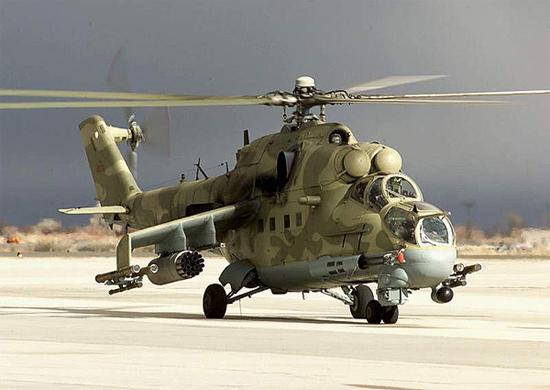l Mil Mi-24, code-named NATO: "Hind", is an AIFV attack helicopter (Armored Infantry Fighting Vehicle) from Mil Moscow Helicopter Plant, based in Moscow, and produced by Rostvertol. Designed for close air support against armored targets in the role of 'gunship', it has the peculiar characteristic of being able to carry fully equipped reinforcement personnel with the possibility of opening fire from special slits in the load compartment along 2,83 meters (up to 8 equipped passengers / paratroopers).
Derived from the Mil-Mi 8, it was developed in the mid-60 years by the Soviet Union; the first prototype was tested in the 1969. The main changes from the Mi8 consisted in the strengthening of armor and armament, at the cost of the reduction of passenger load (25), and in the modification of the 'characteristic' two-seat "double bubble" armored cabin that accommodates the pilot / commander in the rear position, and the pilot / armor in the front position.
The main rotor is five-bladed (diameter 18,8 mt), the three-tailed rotor. The double vertical wing, from the opening of 6,536 mt, allows him higher speed in the vertical movement as well as the load of arms suspended through 6 wing piers. The thrust comes from two Klimov / Isotov TV3-117 turbines with 1.638 kW of power each.
The first version was the Mi-24 'A' (photo below right), produced in series by the 1972 and followed by the improved 'D', operating from the 1976 (the 'B' and 'C' versions, although they exist, are been produced in very few specimens). The modifications in the D version, the main variant, have provided not only a renewed cabin, the equipment under the nose of the helicopter of a revolving turret with a machine gun from 12,7 mm 9A624 to 4 rotating rods with 1.470 blows (cadence of 4000 blows to minute).
The additional armament consisted of 4 mounts with UB-32 rocket launcher blocks for S-5 missiles from 57mm, four 100 or 250 kg free-fall air bombs, or two 500 kg bombs, or the same number transport configuration of napalm containers. The Hind can be otherwise equipped with quadruple rocket launcher for 122 mm air-to-ground rockets. In the sub-winged pilots at each end of the wing there are supports for two 9M 17P 'Fleyta' (NATO name AT-2 'Swatter'), MCLOS (Manual Command to Line Of Sight) high-explosive anti-tank missiles.
The Mi-24 'V' version, or E for NATO classification, a further improvement of the previous ones, was integrated with the modern BVK-24 aera navigation system, equipped with counter-tank missiles capable of exceeding the speed of sound 9K114 Šturm (NATO AT-6 'Spiral' denomination): capacity 5 km, and the armament has been further strengthened through the allocation of B-8V blocks for 20 rockets type S-8 from 80 mm, two UPK-23-250 carriages for house a pair of GS-23L cannons with 250 blows, or provision for installing 9-A-800 launchers, or 'gun-pods' for 9-A-624 machine guns from 12,7 mm or 9-622 from 7,62 mm.
The machine gun under the nose is replaced in the 'F' variant by a double-barreled fixed-bore GSh-30K caliber 30 mm with a firing rate of 2500 per minute, and in the Mi-35M variant by a binary GSh-231 23 mm. Additional possible configurations on the Mi-35 include ATGM (Anti-Tank Guided Missile) 9M120 missiles Ataka, NATO denomination AT-9 Spiral-2, and rockets S-13 from 122 mm. In the 'V' and Mi-35M versions, the last update in production from the 2005, the performance of the TV3-117V turbines has also been improved, in the Mi-35M ТVЗ-117VМА or VК-2500, through special cooling systems, and has been increased autonomy through additional tanks for 450 liters of fuel. The Mi35 was also equipped with a four-blade rear rotor 'X-type'.
The maximum speed reached by the latest versions of the Mi24 is 310 km / h, the cruising speed of 260 km / h and the autonomy of 1.100 km. The maximum tangency that can now be reached is 5.400 mt. The navigation equipment initially included an ADF system with DISS-1SD Doppler-fed. A bullet-proof 'Air data sensor' has always been positioned under the end of the muzzle. The latest versions have integrated the system in addition to the BVK-24 mentioned above observation-sight OPS-24N. For the aiming and use of the weapon relies on the system Raduga-F semi-automatic missile guidance e Raduga-Sh day-vision guidance, while for self-defense they are arranged on both sides of the fuselage and on the edge at the rear end of the tail rotor of the 'Sirena-3M' antennas.
An infrared jammer L-166V-11E Jspanka microwave pulse lamp is placed on the front end of the tailboom and 3 dispensers for 192 Chaff / flare ASO-2V rockets are positioned under the tailboom and in the center of the fuselage.
The armor of the Mi24 allows it to withstand light and medium-range blows up to the .50 caliber (12,7mm). The main rotor blades are also armored, coated in titanium can withstand shocks from 20mm.
The Mil-Mi 24 in its early versions received the baptism of fire during the Invasion of Afghanistan in the 1979, remaining literally invincible enough to earn the nickname "Flying Tank" until the Afghan rebels were supplied by the CIA with missiles with thermal guidance Stinger. The enormous power released by the engines made the 'Hinds' easily traceable which, later, were equipped with cold air mixers to absorb infrared radiation emitted in flight.
Several squads of Mi24 'V' Russians are temporarily deployed in Syria to support Assad's army and the latest news has revealed the use of the latest version Mil-Mi 35M (export). The export version is designated with the initials Mi-25 / 35. Other users of this helicopter model are Iraq, India, Croatia, Armenia, Syria, Serbia, North Korea, Venezuela, Brazil, Azerbaijan.
Of the 2300 units produced, the Russian Federation has 360 in service.
(photo: Russian Fed MoD opening / followed by Mi-24A filmed in Kabul and a Mi-24V ©Online Defense)












